Perspective: Three Reflections on Being a Female Paly Athlete
Being an athlete in high school is about building team camaraderie, making lifelong memories, and, of course, winning. But the experience of being a female athlete at Paly involves significant shortcomings—shortcomings that must be addressed by the Paly community. To Paly, regarding women’s sports: do better.
March 27, 2020
It’s a cult-classic matchup: Paly vs. Los Gatos basketball. The games have been embroiled in a heated, tense rivalry for as long as most Paly students can remember. Countless fights have broken out at Gatos games; countless crass chants have had to be silenced. In our time at Paly, we’ve known the Gatos games to be must-see events, something that unifies the school in its hatred of a common enemy. If you’re not at a Gatos match, you better have a damn good reason.
But the rivalry is a peculiar one; or, maybe, not so peculiar. Maybe we should expect, by now, that the Paly-Gatos rivalry is one hardly extended to women’s sports; while we’ve come to expect the blood, the sweat, the tears spilled in these games, we’ve come to expect them to flow from the bodies of male players only. Think of the Gatos rivalry: do you think of football? Men’s basketball?
Conversely: do you think of women’s games?
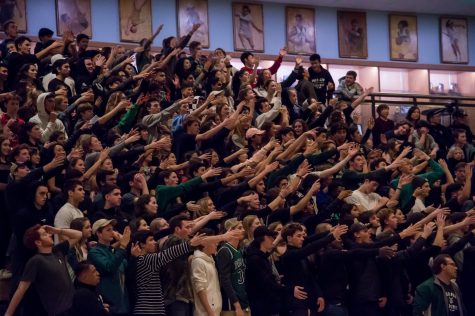
Fans jeer at a boys basketball game.
How often do you hear the Paly community speak of the intense game Paly women’s basketball had versus Gatos? In our experience, that conversation is limited at best, nonexistent at worst. This year, for that classic matchup, Paly came up with an innovative idea. Limit the number of tickets available to 200, but don’t sell any tickets at the actual game. Instead, hand the tickets out for free on the quad. First come, first served – the most passionate fans will get to see the game, and perhaps some of the chaos of the tenuous rivalry can be limited.
But those tickets came with a catch: receive one, and you must be at the game when doors open. That’s to say, when the girls basketball game starts.
It’s an interesting technique to try to promote Paly’s attendance of women’s sports. Bait the fans with a free ticket, force them to come to the earlier time slot, and they’ll have to attend the women’s game before they can enjoy the main event they came for: the men’s game.
True, that may not have been Paly’s intention with the ticketing system. We’re inclined to believe that the plan was one with good intentions in mind, one genuinely aiming to correct the disparity in attendance between male and female sports. It means Paly has, at least, recognized that the disparity exists. It means the school is, at least, trying to find ways to fix that disparity.
But regardless of original intentions, it’s exactly what their plan implies. And it’s a plan contingent on a fact barely mentioned anyway, if ever: men’s varsity sports get the prime time slot of every game, while women play the earlier games. Consider the other instance when one team gets a prime-time slot and the other gets the down-time slot: football. It’s tradition, in football, for junior varsity to go on before varsity. The younger team, the one with less experience, the one less likely to have star players – the star players will simply be promoted to varsity, after all – goes on first. Then, the main event. Whether righteous or not, that’s the existing tradition for football.
And yet, inexplicably, we see the same trend paralleled for women’s sports. What, exactly, should the women’s basketball teams, and additional women’s teams, think, when they’re consistently slotted to go on before the men? The scheduling of matches has made women’s sports analogous to JV games. The less talented; the less valued.
But it’s more complex than a simple scheduling shift. Even if the administration’s scheduling of games seems to implicitly state that women’s games are less important, there’s a reason for the timing that’s just as problematic as institutionalized sexism at Paly would be: Paly students simply don’t care about women’s sports.
The three of us represent a softball player, a lacrosse player, and a powerlifter. We belong to vastly different sports in the Paly community, and yet we’ve all experienced the devaluing of women’s sports by both Paly students and Paly staff in distinct ways.
Softball: Ella Jones
Reflecting on four years of playing about 100 varsity sport games at Paly, I could easily count the games on my hand that students had attended. A comical site is the three steel bleachers lining the backstop— us softball players can all too strongly relate to the universal sensation of Paly women athletes that no one is watching.
Yet the reason no one attends our games may not be necessarily due to lack of interest, but that of faculty. Upon saying I have a softball game later, I’m almost dependably met with: “Paly has a softball team?” To be followed up by: “Paly has a softball field?”
Yes, behind the baseball field and tennis courts, sitting next to the district offices, lies my home. Situated on the edge of El Camino, the outermost boundary of Paly, softball was quite literally kicked to the curb. Boy sports teams score the primetime slots, and it seems they get pull position, too.
Ok, but why whine about having to walk a little farther to the field? What’s the big deal? Well, by situating softball players so out of the way, we are deprived of basic necessities. Bathrooms, for a start. We could go to the small gym, but that’s taking an extra ten minutes out of our practice in travel time that other sports aren’t forced to concede. The district office? A nightmare. Here are the rules enforced on the softball players when using the aforementioned facilities: 1. No cleats. Take them off outside the building. Yes, use the restroom in your socks. 2. One player at a time. This has resulted in having to start our games with positions unfilled due to players waiting to use the restroom.
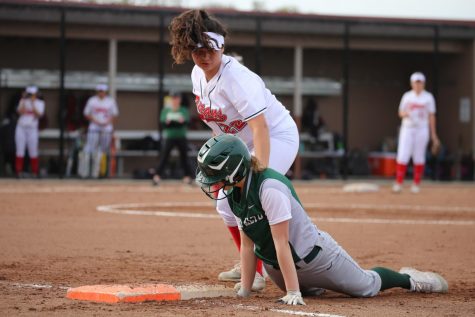
Ella Jones slides to reach base before being tagged out.
What has been most jarring about my experience, however, is the actual feeling of being devalued. To illustrate, when home plate, which is a pretty big deal on the diamond, was stolen from our field and a varsity team was left unable to actually use necessary facilities, no one really cared. No one came immediately, or even for a while after that. We endured several days in which we were unable to practice essential elements of the game which deprived us of time needed to hone our skills and disturbed our team’s momentum in the midst of a season. Do you really think that basketball would go a day without a backboard? Football without the goalposts? Baseball without a home plate? From this experience, one thing was abundantly clear: softball and women’s sports in general are not priorities.
But even on a day-to-day basis, I feel like an inferior athlete. Stand in the softball dugout and close your eyes. What do you hear? It’s baseball’s robust surround sound system blasting country, drowning out all other sound. Sometimes you can hear a walk up song. Other times it’s the announcer’s voice rejoicing in a home run scored by the beloved Vikings. Softball, however, does not have surround sound. We aren’t given the opportunity to choose our music— that space is already monopolized. Once, we brought out a small amp and were able to play some tunes. Five minutes later, the district office demanded we turn it off— noise complaint. More important than music, however, is the announcing. Deprived of surround sound, we are deprived of celebration of our play. Why does the world sing when a boy walks up to the plate, yet remains silent for me? When a boy hits a home run, his name literally echoes and all can recognize him and his achievements. When I hit dingers? Crickets.
I get it. There’s no easy fix to any one of these problems, and it isn’t any one individual’s fault. But that doesn’t mean these issues shouldn’t be brought up so we can start to address them. I’ve played softball for a decade and a half now. I’ve spent each of those years learning, perfecting, and loving my sport. Most of my summers growing up were spent practicing 15 hours a week, taking two hitting lessons (and individual hitting practice each day), catching for pitchers at their lesson, and driving to that weekend’s town to play tournaments in 100 degree heat and get heat stroke three times. Essentially, softball has always been the major part of my life— the thing that I loved most. Well, until I got to high school and encountered a program that had the funds, energy, and life drained from it. In playing high school softball, I came across an idea that had never before crossed my mind: softball didn’t matter. And that meant all the hours and hard-work I was putting in didn’t matter. I stopped playing as much— I felt foolish pursuing something that seemed to have such little impact.
I don’t mean to blame the community at large for making me lose something I loved, but I do want to call others to consider how the lack of support, energy, and enthusiasm directed towards women athletes affect teenage girls. We are teaching them that what they are doing is insignificant – is it a surprise that they tend to stop doing it? And it’s scary to think that we are actively a part of a community that discourages women from sports and, more largely, the things that they love. Can’t we do better?
Powerlifting: Yael Sarig
I won’t pretend the issues I describe are exclusive to Paly – despite how often I feel out of place as a woman in Paly’s weight room, I’d likely feel equally out of place at any other gym. Weight-rooms have long been male-dominated spaces – women are expected to segregate themselves to the treadmills or ellipticals, or to the yoga and pilates classes if they’re feeling adventurous. The men are left to the barbells, to the iron and the accompanying blood, sweat, and tears (hopefully those are thoroughly wiped clean post-workout). It’s not a trend that began at Paly, and it’s one dating back to historical expectations of the man serving as a protector and the woman serving as a housewife.
But this isn’t the 1800s anymore – so why does stepping into our weight room sometimes feel like walking right into a scene from Kate Chopin’s The Awakening?
And I’ll note, too, that for a long time I felt like I was being too sensitive when a small, passing comment bothered me, or when I found an interaction sexist. Am I just looking for sexism where there is none – inventing discrimination because I feel out of place? But the benefit of the doubt has disappeared over the years. There are simply too many moments for them to be seen as coincidence.
I can’t count on two hands the number of times I’ve been using a power rack during peak hours, when the nine additional racks are also occupied by men, and I’m the sole one approached and asked the ever-innocuous: how many sets do you have left? Fortunately, I can count on two hands the number of times someone has physically tried to strip a barbell I’d been using to squat no more than 30 seconds prior, but I really shouldn’t need two hands – or one – to count those instances at all. They shouldn’t happen. I’ve grown past the mentality I had when I started lifting, grown past the fear of occupying space and taking away highly-sought equipment from those stronger than me, but other women certainly haven’t. I don’t mean to make it sound like entering the weight room is a brave feat, but as a woman, embracing a sport that will force you to go against the very ethos of societally-defined femininity is hard enough without needing to constantly defend your position–your right to exist–in the gym.
There are the comments that aim to be supportive, too, but fall flat. I could never pinpoint why it bothered me so much when a man commented on how strong I was when I was on my third warmup set, or when someone asked me where I learned how to lift, or when a male trainer told me that my squats were “pretty good.” Innocent enough, right? I think I’ve come to the realization that what bothered me was being labeled as a Female In The Weight Room – capitalization necessary. If a woman is lifting heavy, it’s cause for praise; if a man is, it’s a normal Tuesday. If a woman is lifting successfully, she must have had a mentor (read: a man) who taught her. If a man is lifting successfully, he’s embracing his natural abilities.
That’s the root of my issue with the weight room: I don’t want to be differentiated. I know you mean well when you ask me how it feels to lift more than some of the guys in there. Well, it feels weird, now that you said that.
I don’t want to paint the weight room as a place that needs fixing, as a place I dislike. It’s my place of solace, and the community there is a loving one. Many of the inhabitants of Paly’s weight room have embraced me as a part of their group, even if we’d never cross paths outside of lifting. I find most people who are truly passionate about lifting to be some of the most accepting, tolerant individuals I’ve known in my time at Paly.
But the culture surrounding the weight room is impossible to ignore. It’s one of machismo, one of an entitlement that tends to exclude women.
Admin is perhaps the worst culprit. I understand that Paly, and the weight room, has a dress code. I also understand that expecting 18 year old women to “cover up” their sports bras is perpetrating a message I’m sure Paly administration doesn’t want to be sending.
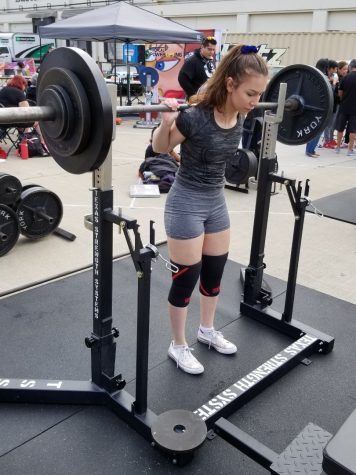
I’m an athlete. It’s taken me time to embrace that moniker, but it’s one that fits. When I lift, clothing that restricts my ability to lift my arms, or that hinders my ability to watch my body as it moves, is a direct impediment to me succeeding at my sport. And as an athlete, a sports bra and shorts function as my uniform. I’ve never had a single interaction with a man in the weight room where I felt objectified because of my dress.
So if Paly staff wants to tell us to cover up, fine. If there are hygienic concerns, fine. What I won’t stand for is the up-and-down once-over, and you telling me that what I’m “doing” is “not okay.” I won’t stand for you saying I’m “distracting the boys,” or that I need to come dressed “appropriately,” or that I’m “indecent.”
Stop sexualizing my body. I am an eighteen-year old woman participating in her sport; I dare you to explain how what I’m doing is inappropriate without turning my body into an object to be picked apart, a set of parts to be ogled at.
To be clear: a sports bra is not sexual. Somehow, we’ve reached the point where saying that necessitates a line of its own.
I’d think that Paly would want to make the weight room a less gender-segregated space; allowing men to wear wife-beater tanks or strip shirtless for posing practice in the mirrors while verbally berating me for exposing my midriff or shoulders is a great way to do exactly the opposite. I’ve been hardened, maybe, by years of dealing with this. I don’t care what you think of my body, or my personality, or the assumptions you make about my character based on a sports bra. But I care for the women who’ll leave the weight room and never return because of those assumptions.
And while we’re at it, save the “it’s part of the dress code” cries – or start reprimanding the group of men who lifts in jeans every single day.
If I sound angry, it’s because I am.
If we sound angry, it’s because we are.
There are no excuses. Do better.
Lacrosse: Sanaz Ebrahimi
As an avid fan of my sport, I can barely ever get through one sentence about my passion before someone blurts out, “Is girls lacrosse even a sport?” “Give me a stick and I can take your entire team one single handedly!” “How do you even make contact in girls lacrosse?”
I understand that there is a stigma around the sport of lacrosse in general. However, I also know that if the topic of interest was boys lacrosse, no one would be questioning the fundamentals of the sport, and would instead be raving about how “sick” the hits look. Due to this ideology, hardly anyone attends our games, and in the past years, the girls team has consistently shown massive support to the boys team without receiving reciprocated support. And team success isn’t the reason—we both get pretty far in SCVALS.
This mindset seemed to translate into our own sports department this year, as the girls lacrosse team lost their coach of 10 years and was left to fend for themselves. This was a heartbreak for me and my fellow captain Kayla Stitt (‘20), as it is our senior year and we were left high and dry with no coach to lead us into preseason workouts or even set expectations for the upcoming season.
We had to set up the entire preseason workout system on our own with no access to a real coach that could supervise us and give us real workouts like the boys lacrosse team had. It felt like no one cared that our team had a reputation to uphold: we were alone.
“We felt there were not enough efforts to find us a coach,” Stitt said. “It came down to a player’s dad having to find the coach.”
After multiple continuous efforts to secure our team a coach, the position was finally filled by a coach found entirely by one of our own teammates who took the initiative to find us one.
After taking the time to find us one coach, the sports department left us be and never reached out again. This is infuriating, as in this same time period the boys have already gotten new uniforms and helmets and we have not even been contacted once about apparel. Last year, we were forced into oversized tops and skirts that restricted our playing and did not even fit most of us.
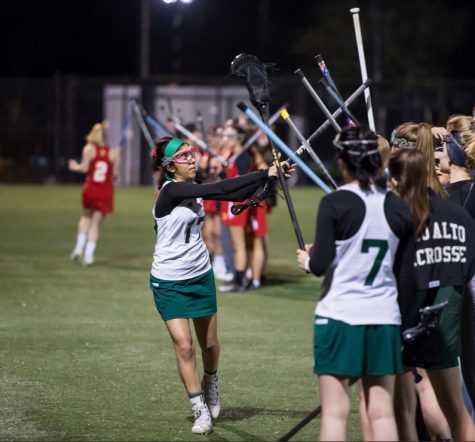
Sanaz Ebrahimi shows her camaraderie with her lacrosse teammates.
This issue might not sound like as big of a deal as I’m making it out to be, but the hurt doesn’t come from the lack of a coach or appropriate uniforms, but the sheer and obvious inequality.
“The boys have a different coach for about every position and we didn’t even have a head coach until two days before tryouts,” Stitt said. “I think the situation would be handled a lot differently if this was the boys team that didn’t have a coach.”
Even after we got our coach, it’s depressing to see how the boys have a coaching staff big enough for seven teams and we barely even found one coach. This gives the boys the benefit of breaking practice up into position-specific drives, preserving their practice time and helping them use it beneficially.
The fact of the matter is these issues happen all over the United States and the world in general, but they shouldn’t be happening when the resources and means are readily available to fix them. Certainly, we at Paly are all well-equipped to treat our boys and girls teams equally. It’s not just about equity; it’s not just about justice; it’s about morale, about providing something—anything—to back up claims that women can expect to be treated in the same way as men at Paly. It’s not on staff, or students, or administration individually. If the situation changes, it’ll be a concerted, communal effort.
But in our opinion, it’s one worth making.



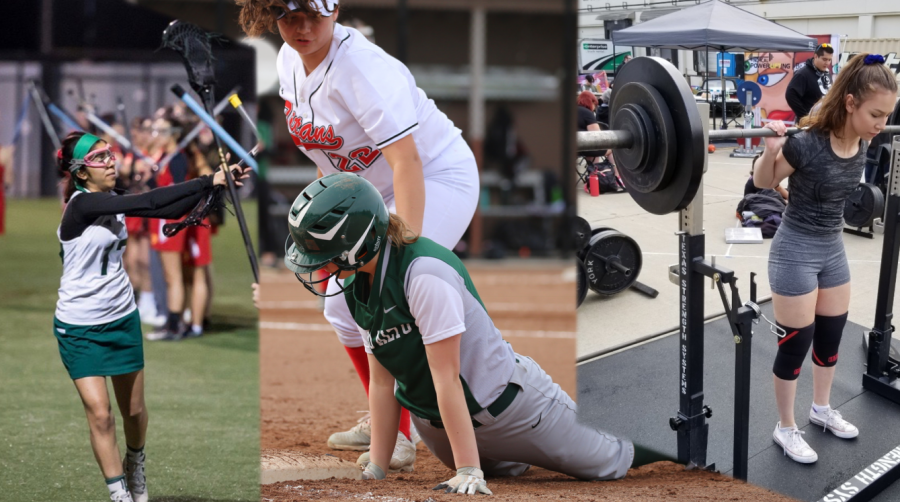





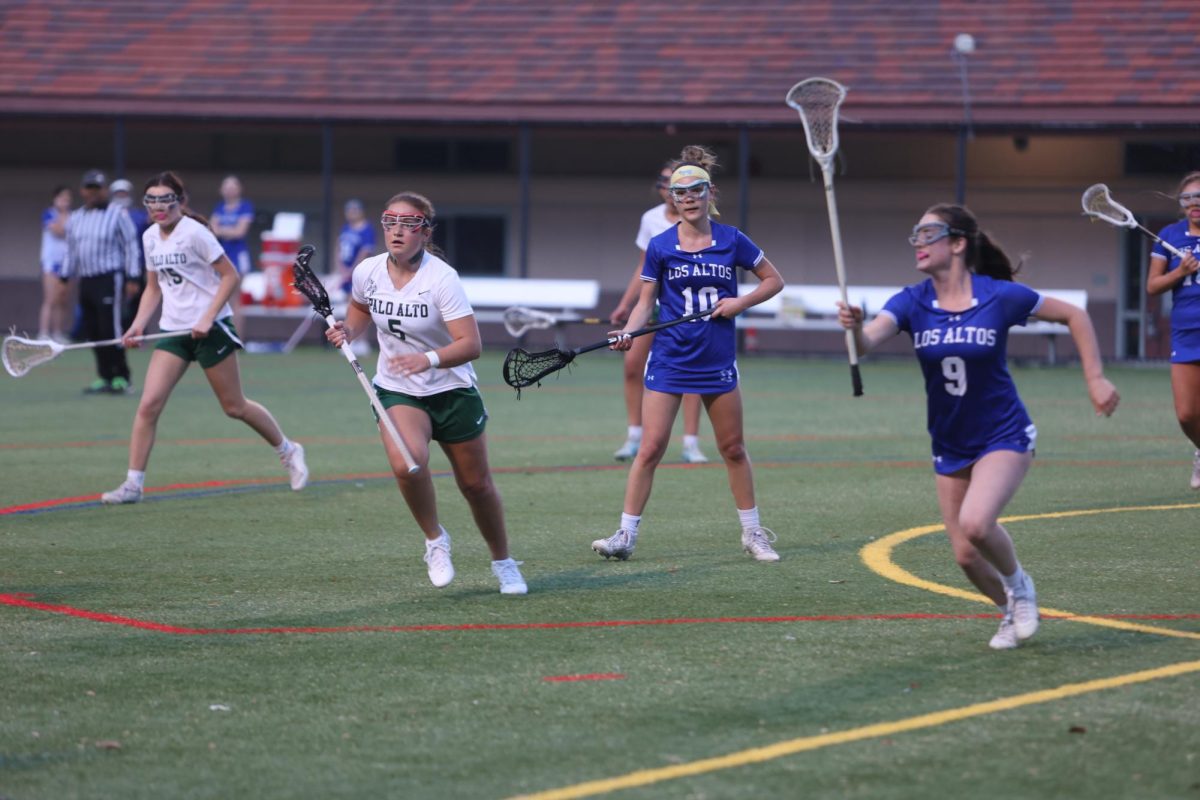





Debbie Whitson • Mar 29, 2020 at 8:33 am
I loved reading this! Thank you for sharing your stories.